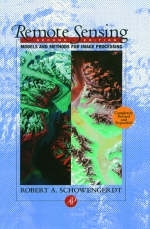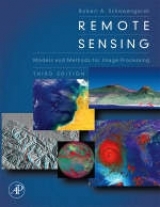
Remote Sensing
Academic Press Inc (Verlag)
978-0-12-628981-7 (ISBN)
- Titel erscheint in neuer Auflage
- Artikel merken
This book is a completely updated, greatly expanded version of the previously successful volume by the author. The Second Edition includes new results and data, and discusses a unified framework and rationale for designing and evaluating image processing algorithms. Written from the viewpoint that image processing supports remote sensing science, this book describes physical models for remote sensing phenomenology and sensors and how they contribute to models for remote-sensing data. The text then presents image processing techniques and interprets them in terms of these models. Spectral, spatial, and geometric models are used to introduce advanced image processing techniques such as hyperspectral image analysis, fusion of multisensor images, and digital elevationmodel extraction from stereo imagery. The material is suited for graduate level engineering, physical and natural science courses, or practicing remote sensing scientists. Each chapter is enhanced by student exercises designed to stimulate an understanding of the material. Over 300 figuresare produced specifically for this book, and numerous tables provide a rich bibliography of the research literature.
The Nature of Remote Sensing: Introduction. Remote Sensing. Information Extraction from Remote-Sensing Images. Spectral Factors in Remote Sensing. Spectral Signatures. Remote-Sensing Systems. Optical Sensors. Temporal Characteristics. Image Display Systems. Data Systems. Summary. Exercises. References. Optical Radiation Models: Introduction. Visible to Short Wave Infrared Region. Solar Radiation. Radiation Components. Surface-Reflected. Unscattered Component. Surface-Reflected. Atmosphere-Scattered Component. Path-Scattered Component. Total At-Sensor. Solar Radiance. Image Examples in the Solar Region. Terrain Shading. Shadowing. Atmospheric Correction. Midwave to Thermal Infrared Region. Thermal Radiation. Radiation Components. Surface-Emitted Component. Surface-Reflected. Atmosphere-Emitted Component. Path-Emitted Component. Total At-Sensor. Emitted Radiance. Total Solar and Thermal Upwelling Radiance. Image Examples in the Thermal Region. Summary. Exercises. References. Sensor Models: Introduction. Overall Sensor Model. Resolution. The Instrument Response. Spatial Resolution. Spectral Resolution. Spectral Response. Spatial Response. Optical PSFopt. Image Motion PSFIM. Detector PSFdet. Electronics PSFel. Net PSFnet. Comparison of Sensor PSFs. PSF Summary for TM. Imaging System Simulation. Amplification. Sampling and Quantization. Simplified Sensor Model. Geometric Distortion. Orbit Models. Platform Attitude Models. Scanner Models. Earth Model. Line and Whiskbroom ScanGeometry. Pushbroom Scan Geometry. Topographic Distortion. Summary. Exercises. References. Data Models: Introduction. A Word on Notation. Univariate Image Statistics. Histogram. Normal Distribution. Cumulative Histogram. Statistical Parameters. Multivariate Image Statistics. Reduction to Univariate Statistics. Noise Models. Statistical Measures of Image Quality. Contrast. Modulation. Signal-to-Noise Ratio (SNR). Noise Equivalent Signal. Spatial Statistics. Visualization of Spatial Covariance. Covariance with Semivariogram. Separability and Anisotropy. Power Spectral Density. Co-occurrence Matrix. Fractal Geometry. Topographic and Sensor Effects. Topography and Spectral Statistics. Sensor Characteristics and Spectral Stastistics. Sensor Characteristics and Spectral Scattergrams. Summary. Exercises. References. Spectral Transforms: Introduction. Feature Space. Multispectral Ratios. Vegetation Indexes. Image Examples. Principal Components. Standardized Principal Components (SPC) Transform. Maximum Noise Fraction (MNF) Transform. Tasseled Cap Tranformation. Contrast Enhancement. Transformations Based on Global Statistics. Linear Transformations. Nonlinear Transformations. Normalization Stretch. Reference Stretch. Thresholding. Adaptive Transformation. Color Image Contrast Enhancement. Min-max Stretch. Normalization Stretch. Decorrelation Stretch. Color Spacer Transformations. Summary. Exercises. References. Spatial Transforms: Introduction. An Image Model for Spatial Filtering. Convolution Filters. Low Pass and High Pass Filters. High Boost Filters. Directional Filters. The Border Region. Characterization of Filtered Images. The Box Filter Algorithm. Cascaded Linear Filters. Statistical Filters. Gradient Filters. Fourier Synthesis. Discrete Fourier Transforms in 2-D. The Fourier Components. Filtering with the Fourier Transform. Transfer Functions. The Power Spectrum. Scale Space Transforms. Image Resolution Pyramids. Zero-Crossing Filters. Laplacian-of-Gaussian (LoG) Filters. Difference-of-Gaussians (DoG) Filters.Wavelet Transforms. Summary. Exercises. References. Correction and Calibration: Introduction. Noise Correction. Global Noise. Sigma Filter. Nagao-Matsuyama Filter. Local Noise. Periodic Noise. Distriping 359. Global,Linear Detector Matching. Nonlinear Detector Matching. Statistical Modification to Linear and Nonlinear Detector. Matching. Spatial Filtering Approaches. Radiometric Calibration. Sensor Calibration. Atmospheric Correction. Solar and Topographic Correction. Image Examples. Calibration and Normalization of Hyperspectral Imagery. AVIRIS Examples. Distortion Correction. Polynomial Distortion Models. Ground Control Points (GCPs). Coordinate Transformation. Map Projections. Resampling. Summary. Exercises References. Registration and Image Fusion: Introduction. What is Registration? Automated GCP Location. Area Correlation. Other Spatial Features. Orthrectification. Low-Resolution DEM. High-Resolution DEM. Hierarchical Warp Stereo. Multi-Image Fusion. Spatial Domain Fusion. High Frequency Modulation. Spectral Domain Fusion. Fusion Image Examples. Summary. Exercises. References. Thematic Classification: Introduction. The Importance of Image Scale. The Notion of Similarity. Hard Versus Soft Classification. Training the Classifier. Supervised Training. Unsupervised Training. K-Means Clustering Algorithm. Clustering Examples. Hybrid Supervised/Unsupervised Training. Non-Parametric Classification Algorithms. Level-Slice. Nearest-Mean. Artificial Neural Networks (ANNs). Back-Propagation Algorithm. Nonparametric Classification Examples. Parametric Classification Algorithms. Estimation of Model-Parameters. Discriminant Functions. The Normal Distribution Model. Relation to the Nearest-Mean Classifier. Supervised Classification Examples and Comparison to Nonparametric Classifiers. Segmentation. Region Growing. Region Labeling. Sub-Pixel Classification. The Linear Mixing Model. Unmixing Model. Hyperspectral Image Analysis. Visualization of the Image Cube. Feature Extraction. Image Residuals. Pre-Classification Processing and Feature Extraction. Classification Algorithms. Exercises. Error Analysis. Multitemporal Images. Summary. References. Index.
| Erscheint lt. Verlag | 2.7.1997 |
|---|---|
| Zusatzinfo | 300 figures, bibliography, b&w and colour illustrations, references, index |
| Verlagsort | San Diego |
| Sprache | englisch |
| Maße | 152 x 229 mm |
| Gewicht | 980 g |
| Themenwelt | Mathematik / Informatik ► Mathematik ► Angewandte Mathematik |
| Naturwissenschaften ► Geowissenschaften ► Geophysik | |
| Naturwissenschaften ► Physik / Astronomie ► Optik | |
| Technik | |
| ISBN-10 | 0-12-628981-6 / 0126289816 |
| ISBN-13 | 978-0-12-628981-7 / 9780126289817 |
| Zustand | Neuware |
| Informationen gemäß Produktsicherheitsverordnung (GPSR) | |
| Haben Sie eine Frage zum Produkt? |
aus dem Bereich



